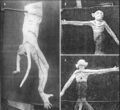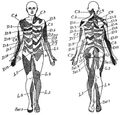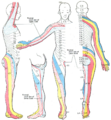Dermatomes: Difference between revisions
No edit summary |
No edit summary |
||
| Line 8: | Line 8: | ||
==History== | ==History== | ||
See Downs et al on the history of dermatome maps.<ref>{{#pmid:21628826}}</ref> | See Downs et al on the history of dermatome maps.<ref>{{#pmid:21628826}}</ref> | ||
<gallery> | |||
File:dermatome map herringham.jpeg|Herringham 1886 - Dissection and theory | |||
File:dermatome map sherrington.jpeg|Sherington 1893 - Severing dorsal nerve roots in monkeys | |||
File:dermatome map head and campbell.jpeg|Head and Campbell 1900 - Zoster eruptions | |||
File:dermatome map lower body Fender after Foerster.png|Fender after Foerster lower body 1933 and 1936 - sensation after surgical resection of adjacent roots | |||
File:dermatome map upper body Fender after Foerster.png|Fender after Foerster upper body 1933 and 1936 - sensation after surgical resection of adjacent roots | |||
File:dermatome map Keegan and garrett.png|Keegan and Garrett 1948 - Hypoalgesia secondary to nerve root compression | |||
</gallery> | |||
==Videos== | ==Videos== | ||
Revision as of 21:32, 14 August 2020
The most up to date dermatome map is probably that published by Lee et al. They created a composite image taken from published data that they thought was the most reliable. [1] The winding band like dermatomal map seen in some textbooks was from Keegan and Garrett is the most flawed of all dermatomal maps and was not included. Lee et al's map is most consistent tactile dermatomal regions for each spinal dorsal nerve root. The midline has minimal overlap, but otherwise there is extensive and variable overlap. Blank areas on the map represent areas where there is very large degree of variability and overlap. The S3, S4, and S5 cutaneous supply is not shown.
Radicular pain does not necessarily follow dermatomal distribution.[2]
History
See Downs et al on the history of dermatome maps.[3]
Videos
- ↑ Lee et al.. An evidence-based approach to human dermatomes. Clinical anatomy (New York, N.Y.) 2008. 21:363-73. PMID: 18470936. DOI.
- ↑ Furman & Johnson. Induced lumbosacral radicular symptom referral patterns: a descriptive study. The spine journal : official journal of the North American Spine Society 2019. 19:163-170. PMID: 29800710. DOI.
- ↑ Downs & Laporte. Conflicting dermatome maps: educational and clinical implications. The Journal of orthopaedic and sports physical therapy 2011. 41:427-34. PMID: 21628826. DOI.






